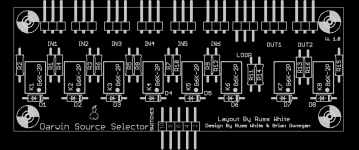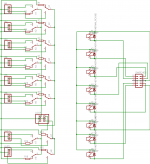Member
Joined 2002
Russ White said:
Wow thats a tall order. 🙂
The current answer is that with the circuit as it is, no you could not, but let me look at it a little closer. Thats a lot of inputs! 🙂
Cheers!
Russ
why some one would use all them inputs is beond me.. thats way to many..
jleaman said:
why some one would use all them inputs is beond me.. thats way to many..
Well, I'm not silly enough to start arguing with an over-90yo 🙂
She has a lifetime of creativity and enjoyment stored in those sources, can you blame her for wanting to keep using them?
Myself, I have the CD, the tuner and the DVD...
Regards,
Michael
Russ White said:
Wow thats a tall order. 🙂
The current answer is that with the circuit as it is, no you could not, but let me look at it a little closer. Thats a lot of inputs! 🙂
Cheers!
Russ
Not at all...
I too would like MANY inputs, 3 or 4, you can find anywhere...
(my collection; Tape, RIAA1, RIAA2, Tuner, MD, CD-R, CD1, CD2, DAC1, DAC2, TV, VCR, DVD, Satelite, Cable = 15) ... and then it would be nice to have a test-input, or two, so I did not need to rewire everytime I wanted to test new-made equipment ;-)
Arne K
johnnyx said:Four tape loops
Actually, I think one tape loop would do, I'd just make up a RCA patch panel to handle the others, I think only one of the tapes is used to record these days...
MULTI SELECTOR
I would like to "chip" in here,
I would like to see say 8
cassette tape,
reel to reel,
tuner
Phono,
CD
2 tape loops
Aux
possible AUx2 or test
I would like to "chip" in here,
I would like to see say 8
cassette tape,
reel to reel,
tuner
Phono,
CD
2 tape loops
Aux
possible AUx2 or test
Actually very well, I should have a prototype in the next couple weeks. 😀 Not too much longer I promise. 
It has changes quite a bit (for the better) and I will post a lot of details soon,
Cheers!
Russ

It has changes quite a bit (for the better) and I will post a lot of details soon,
Cheers!
Russ
Any news on this? 😉
What will you use to control the input? a rotary encoder? or buttons? or a rotary switch?
What will you use to control the input? a rotary encoder? or buttons? or a rotary switch?
C'mon Russ,
I'm needing motivation to get into a project. Renovating the workshop and building a garage has kept me busy, and I'm doing a woodwork course, so the electronics is missing out... (no not a 'powertool' ww course, one where darkside tools are learned, chisels, planes, that sort of thing)
and my ancient friend is still alive, it would make her day... I can see a source selector built into a redgum box...
Michael
I'm needing motivation to get into a project. Renovating the workshop and building a garage has kept me busy, and I'm doing a woodwork course, so the electronics is missing out... (no not a 'powertool' ww course, one where darkside tools are learned, chisels, planes, that sort of thing)
and my ancient friend is still alive, it would make her day... I can see a source selector built into a redgum box...
Michael
maf_au said:C'mon Russ,
I'm needing motivation to get into a project. Renovating the workshop and building a garage has kept me busy, and I'm doing a woodwork course, so the electronics is missing out... (no not a 'powertool' ww course, one where darkside tools are learned, chisels, planes, that sort of thing)
and my ancient friend is still alive, it would make her day... I can see a source selector built into a redgum box...
Michael
Hi Michael,
I always try to remember my Australian mates. Keep your ears to the ground. Darwin is coming. 😀
So many projects, so little time..... Real work always gets in the way. 😎
Cheers!
Russ
Darwin on its way 🙂
Darwin is a 6 in 2 out with loop selector which can be controlled very easily with two switches or three, or a microcontroller, or whatever. It is very flexible. It is designed to very small(1.5" x 4" x .625") and easy to mount even to the back plate of a preamp/amp. The idea is that the source/output switching happens very close to in/out jacks so cable runs for signal can be quite short. The switching relays are very good signal relays (G6K)
The interface wires (to switches or controller PCB) can be as long as you need them without penalty to your audio signal. This makes case wire routing much more practical and easy.
There is an output loop on the PCB so that the signal can pass through a preamp, EQ, or whatever prior to coming out the outputs if you desire. This loop can be jumpered I will use this loop to run the signal through my XBOSOZ/Joshua tree prior to outputs.
The source selector PCB consists of two channels with a common ground trace for all inputs and outputs. So with one PCB you can do stereo single ended with a shared GND. With two relay PCBs stacked and using a common control you could do stereo single ended with distinct switched GNDs or balanced inputs/outputs.
This relay PCB is the exact same size and has the same hole patterns as my attanuator which you can read about here:
http://www.diyaudio.com/forums/showthread.php?s=&threadid=74224
So it is designed to stack with it. And can easily be integrated with the attenuator or the kookaburra (although the kooka will not stack).
Here are some options
A very simple control (no micro controller necessary) just need a +5VDC supply (could easily piggy back off the attenuator PS).
For input a simple 6 position rotary switch , and quality is not very important here as it is not in the signal path.
For output you could do:
A) A 3 position rotory with position A being output 1 position B being output 2 and position C being both.
B) two SPST switched one for each output.
There is also the option of using a microcontroller for remote control and display and such, but there is no such controller yet, but one is coming. For now the relay PCB will be available in about 2 weeks or so.
Cheers!
Russ
Darwin is a 6 in 2 out with loop selector which can be controlled very easily with two switches or three, or a microcontroller, or whatever. It is very flexible. It is designed to very small(1.5" x 4" x .625") and easy to mount even to the back plate of a preamp/amp. The idea is that the source/output switching happens very close to in/out jacks so cable runs for signal can be quite short. The switching relays are very good signal relays (G6K)
The interface wires (to switches or controller PCB) can be as long as you need them without penalty to your audio signal. This makes case wire routing much more practical and easy.
There is an output loop on the PCB so that the signal can pass through a preamp, EQ, or whatever prior to coming out the outputs if you desire. This loop can be jumpered I will use this loop to run the signal through my XBOSOZ/Joshua tree prior to outputs.
The source selector PCB consists of two channels with a common ground trace for all inputs and outputs. So with one PCB you can do stereo single ended with a shared GND. With two relay PCBs stacked and using a common control you could do stereo single ended with distinct switched GNDs or balanced inputs/outputs.
This relay PCB is the exact same size and has the same hole patterns as my attanuator which you can read about here:
http://www.diyaudio.com/forums/showthread.php?s=&threadid=74224
So it is designed to stack with it. And can easily be integrated with the attenuator or the kookaburra (although the kooka will not stack).
Here are some options
A very simple control (no micro controller necessary) just need a +5VDC supply (could easily piggy back off the attenuator PS).
For input a simple 6 position rotary switch , and quality is not very important here as it is not in the signal path.
For output you could do:
A) A 3 position rotory with position A being output 1 position B being output 2 and position C being both.
B) two SPST switched one for each output.
There is also the option of using a microcontroller for remote control and display and such, but there is no such controller yet, but one is coming. For now the relay PCB will be available in about 2 weeks or so.
Cheers!
Russ
Attachments
Re: Darwin on its way 🙂
perfect!!
Russ White said:Darwin is a 6 in 2 out with loop selector which can be controlled very easily with two switches or three, or a microcontroller, or whatever. It is very flexible. It is designed to very small(1.5" x 4" x .625") and easy to mount even to the back plate of a preamp/amp. The idea is that the source/output switching happens very close to in/out jacks so cable runs for signal can be quite short. The switching relays are very good signal relays (G6K)
...
Cheers!
Russ
perfect!!
Russ White said:Here is the Darwin Schematic:
I don't see a "Buy now" button on the web site... 😉
Member
Joined 2002
rabstg said:
I don't see a "Buy now" button on the web site... 😉
He would not be sleeping if he had that button 🙂 I like the work you are doing on all these project's keep up the good work Brian & Russ.
I don't see a "Buy now" button on the web site...
I'm actually trying to add it to the NEW website and get that out the door, instead of updating both the old site and the new site. Check again tomorrow (depending on how late I can stay up tonight 😉 ).
- Status
- Not open for further replies.
- Home
- Amplifiers
- Chip Amps
- New input/output Selector



